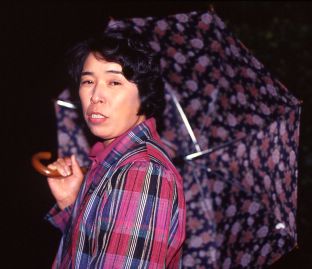
Okusan, pretty in pink.
Details and larger version

That meant I had to step in and take over her duties. My work day was extended an hour, but it was the loss of break times I felt the most.
My day began at 6 a.m.
with kitchen duty, preparing a traditional Japanese breakfast for
four. I also walked and fed our five dogs and washed and hung three
loads of laundry before serving breakfast at 7:30 a.m.
I was settled into my
workshop chair by 8 a.m. and left it only to prepare and serve ocha
(green tea) for break time and to cook another traditional meal for
lunch. What used to be my postlunch break was now a shopping
spree to gather the necessary items for the next couple of meals. I
confess that cooking lunch and dinner had me sweating bullets. Even
familiar items such as hoorensoo (spinach) were prepared
zenzen chigaimasu (altogether differently) than I'm
accustomed to. Okusan happens to be an excellent cook, so I warned
the family they might be a few kilos lighter by the time she
returned. But I'm proud to report that no one starved or was
poisoned while I was in charge.
I left the workshop a half
hour earlier than normal to take down and fold the laundry, prepare
the dog food, and begin dinner. After walking and feeding the dogs
again, cooking and serving dinner, preparing the ofuro
(bath), and cleaning the kitchen, it was about 8 p.m. and I could
finally call it a day.
This experience gave me a much better
understanding of the life of a Japanese woman as well as an
appreciation of Okusan's stamina and culinary expertise. I'm sure
everyone in this household was thrilled to have her return. I know I
certainly was. After one week I was thoroughly exhausted and
counting the hours until I saw her cheerful smile again. Even though
my body was in constant overdrive that week, my mind occasionally
wandered off to relive a wonderful day of complete yasumi
(holiday).
It was a rainy Saturday (a
regular work day for me) when Hidekosan (Hideko Metaxas) brought a
tour through our lovely part of Japan. Before stopping at
Mitsuyasan's nursery, Tokai-En, they visited a wonderful suiseki
exhibition in the neighboring city of Hamamatsu. Yochan (my sempai
– senior colleague) and I were invited to tag along for the
day. So we donned our best duds and headed south to meet the group.
I recognized a number of
friends on the bus, so I knew I'd be in for a fine day of
frolicking. But most of the socializing stopped as soon as the
suiseki exhibition was opened. Ishizusan, one of Mitsuyasan's bonsai
clients and an avid collector of suiseki, was one of the organizers
of this show. He was a terrific host who showed us around and
answered our many questions.
The first stones we
viewed were traditionally displayed. We removed our shoes to enter a
tatami-covered floor. The fifteen or so stones in this room
were truly exquisite. But since they were placed on stands that were
set on the floor, and therefore only shin high, one had to bend very
low to appreciate their beauty. I was busy photographing the stones
but did take a minute to admire the sight of some very tall gaijin
(foreigners; my American pals) with their bellies to the mat.
We spent less time
there than I would have liked because the majority of stones in this
show were displayed in a large exhibition hall, so off we went to
see the rest. But just outside this room I noticed an alcove covered
in gold leaf with a small tree-shaped stone. The carved wooden stand
that held the stone resembled nebari (surface roots).
The large half of the
exhibition hall had stones on tables, so it took just a slight bend
to admire their beauty. About half the stones were formally
displayed with scrolls and accents. I'd never seen so many
magnificent stones before. There were suiseki from all parts of
Japan, with a full range of colors, shapes, and textures. Most of
these stones were small enough to be lifted by one hand.
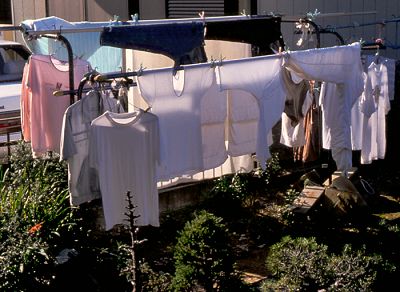
Just a portion of our daily laundry.
Larger version
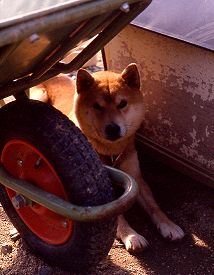
Our bonsai-loving pooch also calls it a day.
Details and larger version
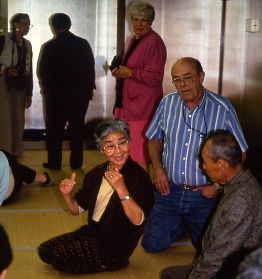
Hideko Metaxas (center) talks to Ishizusan (far right).
Larger version
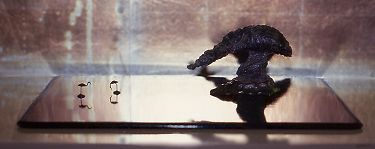
Tree-shaped stone.
Details and larger version

|
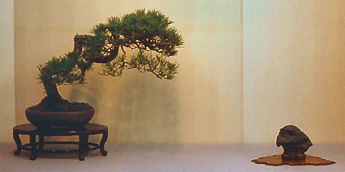
|
|
|
Eagle head stone.
Details and larger version |
With a pine bonsai in a formal display.
Details and larger version |

Oh, well, there's always the baiten (vendors booth). This show had a small but nice baiten where a number of the tour group spent their spare yen.
Our next stop was Ishizusan's house. Many brave souls with casa (umbrellas) in hand braved the weather to view the spectacular bonsai in his garden. Off came our shoes as we were ushered into the house to view more suiseki. Ishizusan showed us some very old and valuable stones and suiban (display trays for suiseki). He'd set out beautiful stones throughout the room so everywhere you turned, there was a treasure to behold.

Before boarding the bus, most people made their way to his rock house – a shed-sized structure that houses Ishizusan's less valuable stones. I considered each one a masterpiece, but they don't have the history that the ones stored in his home have.
Before we went to Mitsuyasan's house for lunch, we had one last stop in Hamamatsu. We went to a restaurant to view their garden. And what a garden! The proprietor used the surrounding mountains in his landscape design to create one of the prettiest sights I've seen so far.

Unfortunately, the rain was pelting us by then, so most were content with a quick peek at the pristine view before hightailing it back to the bus. I managed to get a few good shots with my camera before it broke down from all the moisture. But no amount of ame (rain) could dampen my spirits on that heavenly spent day in Hamamatsu with friends. Thanks, Hidekosan.
[ Top of page | Go back | Go forward | "An Apprentice in Japan" contents | Site contents | Home | ]